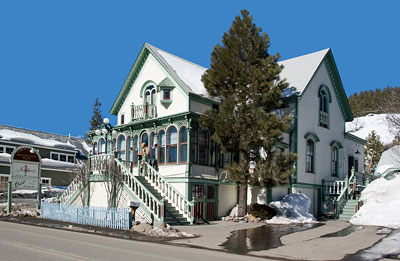National Register of Historic Places in Nevada County
Kruger House
10292 Donner Pass Road
Truckee
Built 1873
The Kruger House is a striking example of the earlier architecture of Truckee. W. H. Kruger, a local lumberman and entrepreneur, built this home in 1873. Kruger contributed significantly to the 19th century community development of Truckee as one of the town's leading commercial pioneers.
In 1863, the Central Pacific Railroad Company began work on a railroad pass through the Sierra which, six years later, would help provide a transportation link between the Atlantic and Pacific Oceans. With the coming of the railroad, many new towns developed along the proposed rail route.
W. H. Kruger and his partner, Mr. Brickle, with as many as thirteen other lumber entrepreneurs, responded to the railroad's demand for lumber. By 1868, these lumbermen had established companies in the new railroad town of Truckee.
Kruger's business success allowed his family to build this elegant home on the north side of the Truckee River in a section of Truckee referred to, in those days, as Brickletown - named after Kruger's partner.
The L-shaped house has classically based detailing evident in the boxed cornice, frieze, and endboards.
It also incorporated a number of stylistic details associated with the more formal Italianate villas of the preceding decade, including the Tuscan windows in the east, west, and south gables, the segmental arch windows on the first floor, a small, almost formal, balcony above the main entrance, and the bracketing and rhythmic arcade-like quality of the sun porch.
The result is an eclectic, eye-catching building with sufficient stylistic pretension to distinguish it as the home of a family of importance.
Adapted from the NRHP nomination.
